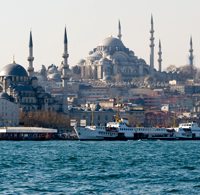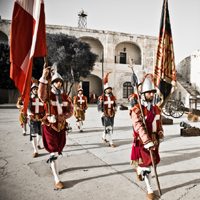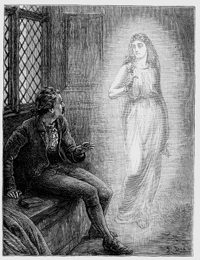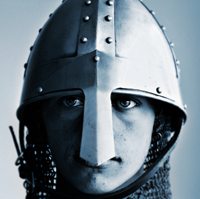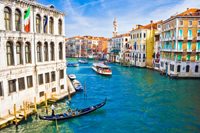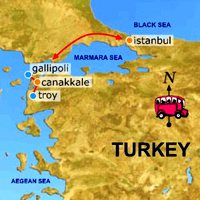Child Reincarnation Story of Ibleto di Challant | Giuseppie Costa: Same Facial Features in Two Incarnations
- CATEGORY
How Derived: Past Life Memories in Childhood and Guidance by Spirit Beings
Researcher: Giuseppie Costa
From: European Cases of the Reincarnation Type, by Ian Stevenson, MD and From the Beyond to This Life, by Giuseppie Costa
Article by: Walter Semkiw, MD
From the Beyond to This Life
In his book, Giuseppe did not provide his date of birth, but Stevenson estimated that he was born around the year 1880. Giuseppe grew up in a small town in Italy called Gonzaga, near Mantua. He was trained and worked as an engineer.
Child Past Life Memories of Constantinople and a Military Campaign
Giuseppe Costa’s story started in childhood, when a painting that this parents had in their home triggered memories of a past lifetime. The painting was of the city of Constantinople, now called Istanbul, in Turkey, which is pictured to the right. The painting featured the river that runs through the city, which is called the Bosporus. Ian Stevenson summarized Giuseppe’s memories, stimulated by the painting, as follows:
“Scenes of large numbers of armed men, ships sailing, banners flying, the noise of battle, mountains, the sea stretching to the horizon, hills covered with flowers.” (1)
A Dream of Sailing to Venice and Battle in a Sunny Land
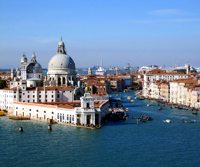 At the age of 10, his father took Giuseppe to Venice, where he experienced a very vivid dream. A description of Giuseppe’s dream is provided below:
At the age of 10, his father took Giuseppe to Venice, where he experienced a very vivid dream. A description of Giuseppe’s dream is provided below:
“After a long journey in boats, through rivers and canals, we arrived in Venice. We traveled in barques filled with armed soldiers in the clothing of the Middle Ages. I seemed to be about 30 years old and had some kind of command.
After a stay in Venice, we embarked in galleys on which two banners waved: a blue one with the image of the Virgin Mary among golden stars, and that of Savoy, red with a white cross.
On the larger galley, which was more painted and decorated, there was someone to whom everyone showed great respect and who spoke to me with great friendliness. Then came the sea, seemingly endless, stretching beyond the horizon. Then we disembarked in a sunny land with a clear sky of cobalt blue.
Then the army disembarked again and landed in a different place. There the troops were coordinated; there were tents full of soldiers, beneath a city with old towers bristling with armaments.
Then came our assault, a battle of tremendous violence ending when we broke into the city. Then finally came the march of our splendid army into the city with its domes of gold on the wonderful bay. This was the magnificent city, Constantinople, depicted in the painting of in our house in Gonzaga, as I learned later.” (2)
Giuseppe realized that the images of this vivid dream replicated images he had when he was gazing on the painting of Constantinople in his parent’s home, years before. Giuseppe noted that his earlier memories were scattered, while the dream in Venice put the images in logical order.
Giuseppe’s Early Interest in Military Affairs & A Sense of Shame in Church from a Past Lifetime
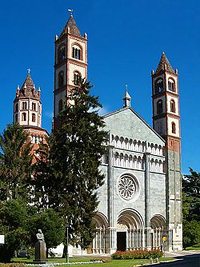 As a young man, Giuseppe showed an enthusiastic interest in firearms, fencing and horseback riding. He volunteered for military service and was appointed a second lieutenant in the Royal Cavalry of Piedmont. He loved military life. It came naturally to him, as if he had lived the life of a military man before. He was stationed in the city of Vercelli, which is located between Milan and Turin.
As a young man, Giuseppe showed an enthusiastic interest in firearms, fencing and horseback riding. He volunteered for military service and was appointed a second lieutenant in the Royal Cavalry of Piedmont. He loved military life. It came naturally to him, as if he had lived the life of a military man before. He was stationed in the city of Vercelli, which is located between Milan and Turin.
In Vercelli, Giuseppe had an unusual emotional experience at the Church of San Andrea, which is pictured to the right. He was walking by the church and was drawn by music that emanated from it. Inside the church, he felt a great sense of repentance, which was very unpleasant. He didn’t know why he had this reaction, but he speculated this feeling of shame may have had something to do with a ceremony that he participated in, perhaps in a past incarnation.
Giuseppe Has an Out of Body Experience
After his term in the army, Giuseppe returned home and focused on caring for and supporting his family. His interest in a past lifetime which involved a military campaign that started in Venice and ended in Constantinople faded.
Unexpectedly, Giuseppe had an out-of-body experience, which reignited his belief in the supernatural. He had been studying for his engineering exams and stayed up late one night. Exhausted, he fell asleep in his bed and during the night, he knocked over an oil lamp, which filled the room with smoke.
The fumes awakened him and he found himself floating over his body. He was surprised to be able to see through the wall into his mother’s room, where Giuseppe saw his mother opening a window to get rid of the oil fumes that had also entered her room. He than saw her run into his room and open the window in his room.
Afterwards, Giuseppe asked his mother if she had indeed opened the window in her room before she came into his room. His mother confirmed that she did, which for Giuseppe verified that his ability to see through the wall that separated their rooms was real. This incident also supports the premise that our consciousness can retain awareness outside of the body; that we are indeed spirit beings.
A Spirit Being Appears to Provide a Clue to Giuseppe’s Past Life
The next chapter in Giuseppe’s reincarnation saga takes place on a vacation trip he took with two friends. They went to see three castles in the valley of Aostas, in Italy, near the border with France. Giuseppe noted that he had three different emotional reactions at these castles. The three castles visited and the associated emotions were as follows:
Castle at Fenis: Giuseppe had no emotional reaction.
Castle at Ussel: Giuseppe felt a sense of sadness and oppression.
Castle at Verres: At this location, pictured above and to the right, Giuseppe was profoundly moved with emotions. The predominant feelings he experienced were great love and significant regrets.
After he and his friends returned to where they were lodging, Giuseppe decided to return to the Verres castle at sunset. A storm then descended on the castle, which forced him to spend the night there.
During the night at the castle at Verres, Giuseppe awoke and saw a phosphorescent light, which enlarged and transformed into a woman. Giuseppe got up from his resting place and walked to the vision of the woman. As he approached her, Giuseppe felt a deep, deep sense of love. The woman then said:
“Ibleto! I wanted to see you again once more before divine death unites us once more…Read near the tower of Albenga an account of one of your past lives…Remember me and that I am waiting for you until the time comes.” (3)
Verification of Giuseppe’s Past Lifetime at the Castle of Albenga
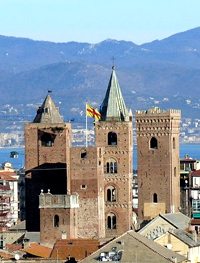 This incident with the apparition made Giuseppe research the possible past lifetime. Having had the experience with a spirit being at the castle at Verres, he researched its history. He learned that a man named Ibleto di Challant had built the castle in 1380 and that Ibleto was a trusted counselor to Amadeus VI, Count of Savoy.
This incident with the apparition made Giuseppe research the possible past lifetime. Having had the experience with a spirit being at the castle at Verres, he researched its history. He learned that a man named Ibleto di Challant had built the castle in 1380 and that Ibleto was a trusted counselor to Amadeus VI, Count of Savoy.
He next decided to follow the advice of the spirit being and Giuseppe visited Albenga, pictured to the right, to find the tower where the woman said a clue to one of his past lifetimes would be found. Giuseppe discovered that there were several towers near Albenga. One of them, though, was owned by a descendant of di Challant family, the family that had owned the castle at Verres, where he had seen the spirit being.
Giuseppe Finds his Past Life Story
Giuseppe met the owner of the tower, the Marquis Del Carretto di Balestrina, who had preserved a biography of Ibleto di Challant, the man who owned the Verres castle. The biography was an unpublished book written by Boniface II, the owner of the Fenis castle, the site where Giuseppe had no emotional reaction.
Giuseppe found that in reading the biography of Ibleto, he found that events in Ibleto’s life corresponded with the images Giuseppe saw in his childhood memories of a past lifetime, in the scenes stimulated by gazing at the painting of Constantinople and in his dream that occurred in Venice when he was ten.
Ibleto di Challant and the Count of Savoy
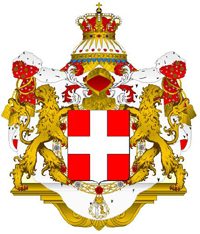 Ibleto was born in 1330. From childhood, he was involved in the court of Amadeus VI, the Count of Savoy. The Savoy coat of arms is provided to the right. Ibleto later became a military companion and advisor to Amadeus. Eventually, Ibleto inherited the castle at Verres, as well as other properties, such as the castle at Montjovet. Other family members inherited other estates, such as the castle at Ussel.
Ibleto was born in 1330. From childhood, he was involved in the court of Amadeus VI, the Count of Savoy. The Savoy coat of arms is provided to the right. Ibleto later became a military companion and advisor to Amadeus. Eventually, Ibleto inherited the castle at Verres, as well as other properties, such as the castle at Montjovet. Other family members inherited other estates, such as the castle at Ussel.
Ibleto Falls in Love
Ibleto fell in love with the sister of Amadeus VI, who was called Blanche of Savoy. He wanted to marry her, but Amadeus had engineered an arranged marriage for his sister with the Lord of Milan. In the end, Ibelto married Giacometta di Chatillon, a union that his father had arranged. Giuseppe and Giacometta were married on September 28, 1350. Giacometta must have died before Giuseppe, as records indicate that he remarried later in life.
Reincarnation & the Crusades: The Capture of Gallopoli & Constantinople
 In 1366, Ibleto went with Amadeus VI on a crusade against the Turks at Constantinople. The Crusades were a series of military campaigns involving European Christian soldiers who sought to free Jerusalem from Islamic forces.
In 1366, Ibleto went with Amadeus VI on a crusade against the Turks at Constantinople. The Crusades were a series of military campaigns involving European Christian soldiers who sought to free Jerusalem from Islamic forces.
Amadeus organized his army initially in Venice. They then went on to Morea in Southern Greece to regroup. From there, his forces traveled to Gallipoli, which was occupied by Islamic Turks. Amadeus’s troops were victorious in battle and the Turks surrendered Gallipoli. From there, Amadeus and his army marched onto Constantinople, which they took without resistance. From there, Amadeus and his troops turned back and returned to Italy.
The Rebellion in Biella, the Capture of the Bishop of Vericelli & Ibelto’s Excommunication
In 1378, Ibleto was involved in military action once again. Historical records indicate that he put down a rebellion in the city of Biella, which is near the Turin. Amadeus captured the Vatican’s representative, the bishop of Vercelli, who apparently was involved in the rebellion. Ibleto had the bishop imprisoned at his castle at Montjovet. The Pope, in retaliation, excommunicated Ibleto for holding the bishop at Montjovet.
Reincarnation & the Vatican: Ibleto is Humiliated at the Church at St. Andrea, Where Giuseppe Felt Repentance
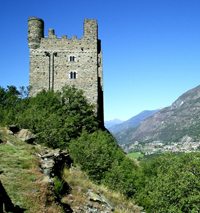 Later, the Vatican offered to lift the sentence of excommunication if Ibleto publicly expressed his repentance to the bishop of Vercelli in a ceremony to be held in the church of St. Andrea. Ibelto agreed an endured this spectacle of public humiliation.
Later, the Vatican offered to lift the sentence of excommunication if Ibleto publicly expressed his repentance to the bishop of Vercelli in a ceremony to be held in the church of St. Andrea. Ibelto agreed an endured this spectacle of public humiliation.
Recall that Giuseppe had experienced a great feeling of repentance when he visited the church of St. Andrea, when he was stationed in Vercelli during his military career.
Guiseppe’s Sadness at The Castle at Ussel & Ibleto’s Shame
Giuseppe also learned that Ibleto’s family members, who held the castle at Ussel, featured to the right, had brought great shame to him when they began robbing the people who lived in the valley below the castle. The Count of Savoy punished these family members by imposing a fine, but the family name was marred. Giuseppe now understood why he had feelings of sadness and oppression when he visited the castle at Ussel.
Reincarnation & Appearance or Physical Resemblance: Ibleto di Challant & Giuseppie Costa
Giuseppe Costa a found portrait of Ibleto di Challant, which he published in his book. Ernesto Bozzano, a researcher who investigated this case, noted that the faces of Ibelto and Giuseppe were so similar that one may have mistaken one for the other. Both men were very large in stature and both had a military bearing.
Spirit Being Guidance to a Past Life Biography
Giuseppe Costa was able to validate memories of a past lifetime through the biography that he found in the possession of the Marquis Del Carretto di Balestrina, the owner of a tower in Albenga.
Perhaps the most striking aspect of this case is how Giuseppe found the biography. Recall that he was spending the night at the castle at Verres when a female ghost or spirit being welcomed him with great love and told him that he would find information on his past lifetime in a tower at Albenga, which is on the French Riviera.
As such, this spirit being who appeared in a castle in Italy near the French border was advising Giuseppe to go to a tower on the French Riviera approximately 140 miles or 225 kilometers away.
As both Giuseppe and Ian Stevenson, MD have noted, what is the probability of finding the biography at Albenga, 140 miles/225/kilometers away, by chance?
Further, Giuseppe pointed out that between 1300, when it was written, and 1900, when he found the biography in Albenga, the biography could have landed in the hands of one of many relatives. What are the odds that it would land in same place that the apparition told him that he would find information regarding his past lifetime?
This case clearly demonstrates that a spirit being facilitated the investigation of a past lifetime.
Who was the female spirit who appeared to Giuseppe in the Verres castle? Giuseppe’s three primary candidates were Blanche of Savoy, who Ibleto loved, but was not allowed to marry; Giacometta di Chatillon, who became his first wife; and finally, his second wife, who was unnamed in this narrative.
Confirmation of a Past Life Dream
Let us review aspects of Giuseppe’s dream that he experienced in Venice at the age of ten, and events in the life of Ibelto di Challant, as revealed by his biography and other records:
1. Dream: “After a long journey in boats, through rivers and canals, we arrived in Venice. We traveled in barques filled with armed soldiers in the clothing of the Middle Ages. I seemed to be about 30 years old and had some kind of command.”
Biography: In 1366, Ibleto went with Amadeus VI on a crusade against the Turks at Constantinople. Amadeus initially organized his army in Venice.
2. Dream: “After a stay in Venice, we embarked in galleys on which two banners waved: a blue one with the image of the Virgin Mary among golden stars, and that of Savoy, red with a white cross.
On the larger galley, which was more painted and decorated, there was someone to whom everyone showed great respect and who spoke to me with great friendliness. Then came the sea, seemingly endless, stretching beyond the horizon. Then we disembarked in a sunny land with a clear sky of cobalt blue.”
Biography: Amadeus organized his army initially in Venice. They then went on to Morea in Southern Greece to regroup. Morea may be the location that Giuseppe saw in his dream that the army disembarked on. In his dream, the man who people respected and who showed great friendliness to Guiseppe would have been Amadeus VI.
3. Dream: “Then the army disembarked again and landed in a different place. There the troops were coordinated; there were tents full of soldiers, beneath a city with old towers bristling with armaments. Then came our assault, a battle of tremendous violence ending when we broke into the city.”
Biography: From Morea in Southern Greece, the army of Amadeus VI traveled to Gallipoli, which was occupied by Islamic Turks. Amadeus’s troops were victorious in battle and the Turks surrendered Gallipoli. As such, the assault and capture of a city in Giuseppe’s dream was likely the capture of Gallipoli from the Turks by Amadeus, Ibelto and their troops.
4. Dream: “Then finally came the march of our splendid army into the city with its domes of gold on the wonderful bay. This was the magnificent city, Constantinople, depicted in the painting of in our house in Gonzaga, as I learned later.”
Biography: Amadeus and Ibelto did enter Constantinople. One discrepancy is that historical records, Amadeus took Constantinople without resistance. As such, it appears that in Giuseppe’s dream, the capture of Constantinople was confused with the assault on Gallipoli.
Understanding Past Lives & Principles of Reincarnation
Physical Resemblance: Of significance, it was observed from a portrait of Ibleto that the resemblance between Ibleto and Giuseppe was so close that they were indistinguishable. Not only were facial features the same, they both had large builds and military bearing.
Geographic Memory: Also note that past life locations, including Venice, the castles of Verres and Ussel, and the church at St. Andrea, stimulated memories or emotions in Giuseppe. We have also observed this phenomenon of geographic locations stimulating past life memories and emotions in the cases of John B. Gordon | Jeff Keene, Francesco Foscari | Wayne Peterson and Louise Vanderbilt | Wayne Peterson.
Spirit Being Involvement: A dramatic aspect of this reincarnation case is that it was solved through the assistance of the female spirit being who appeared to Giuseppe at the castle at Verres. This spirit being welcomed him with great love and told him that he would find information on his past lifetime in a tower at Albenga, on the French Riviera. As such, this spirit being advised Giuseppe to go to a tower approximately 140 miles or 225 kilometers away from the castle of Verres, where he did find the biography with allowed him to validate his past lifetime.
This is reminiscent of the case of Carroll Beckwith | Robert Snow, as Captain Snow was led from Indianapolis to New Orleans, where he found the painting of the hunchback woman which he had seen in a past life regression. Finding the painting of the hunchback allowed Captain Snow to validate his past life memories objectively.
One difference is that Captain Snow was led to the painting unconsciously, through apparent telepathic communications from the spirit world. In contrast, Guiseppi seems to have had some clairvoyant abilities, as he was able to actually see the female spirit being, who helped him solve his case.
Summary: Past Life Memories, Physical Appearance & Spirit Being in a Fascinating Reincarnation Story
Given that this case involves validation of past life memories, observation of physical resemblance from one lifetime to another and geographic locations stimulating past life memories, emotions and even a spirit being, we owe a great deal of appreciation to Giuseppe Costa for publishing his story and to Ian Stevenson for preserving it in European Cases of the Reincarnation Type. It is indeed a very rich and fascinating reincarnation case.
Footnotes
1. Stevenson, Ian: European Cases of the Reincarnation Type, McFarland, 2003, page 16
2. Stevenson, Ian: European Cases of the Reincarnation Type, McFarland, 2003, page 16
3. Stevenson, Ian: European Cases of the Reincarnation Type, McFarland, 2003, page 18
